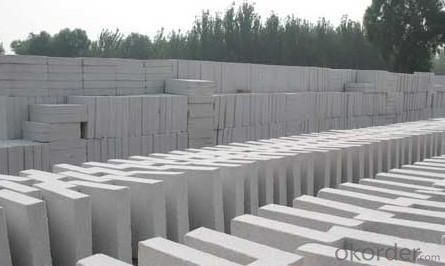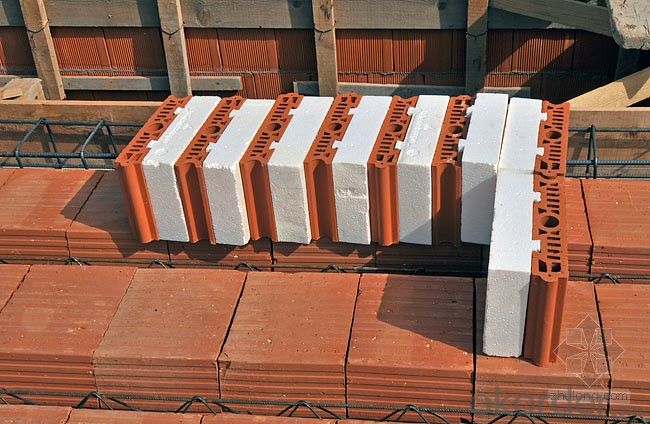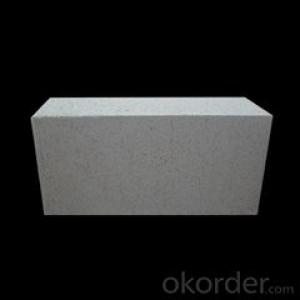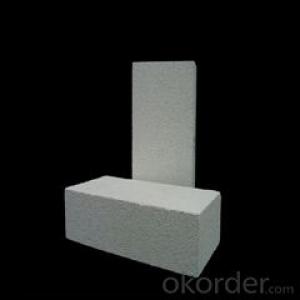Refractory mullite insulating refractory brick JM 92
- Loading Port:
- Shanghai
- Payment Terms:
- TT OR LC
- Min Order Qty:
- 5000 kg
- Supply Capability:
- 10000 kg/month
OKorder Service Pledge
OKorder Financial Service
You Might Also Like
Refractory mullite insulating refractory brick JM 23
Okorder series heat insulation brick
Okorder series thermal insulation brick is an effective, energy saving, low carbon, environmental protection advanced, according to the ASTM standard manufacturing products. Okorder series products are best Li Ning and insulation in all types of industrial furnaces in the metallurgical field, aluminum, petrochemical, electric power and glass ceramic materials. They can be used as part of the working layer of thermal insulation or non - melting. Products have been widely used in the following furnace, achieved satisfactory results.
Application of heat preservation brick
Metallurgical Industry: blast furnace, hot blast furnace, heating furnace, etc..
Petrochemical Industry: ethylene cracking furnace, hydrogen production furnace, primary reformer, heating furnace, etc..
Ceramic industry: roller kiln, kiln, etc..
Glass industry: glass furnace regenerator, etc.
Carbon industry: carbon furnace, etc..
Aluminum electrolysis industry: aluminum reduction cell, etc.
Other industries: tunnel kiln, shuttle kiln, etc..
Advantages of heat insulation brick
Low thermal conductivity: more porosity will bring good thermal insulation effect, energy saving.
High crushing strength: high crushing strength, volume stability.
Low heat storage: small heat storage to absorb more heat, energy-saving effect is obvious.
Gao Chundu: iron, alkali metal impurity content is low.
The precise size: Brick size processing precision, special shape cutting and grinding, accelerate the brickwork.
Insulating brick picture
Common problem solutions
1. What products do you have?
We have all kinds of refractory bricks, refractory casting materials, mortar, cement, ceramic fiber products, etc..
Or you can browse our products to choose what you need.
2. How to control product quality?
With strict quality control system throughout the material selection and production process, we have the quality of refractory materials and ceramic fiber products to meet customer requirements.
From the selection of raw materials, the quality of our control to start. The quality certificate of the raw material is required, each batch of the products are to be tested in the use of the forward line. In the production process, the quality control by the workers, and then each piece of classification, and through the quality supervision and inspection.
3. Can you give me a brief introduction to the application of your product?
My company is mainly engaged in refractories in the steel, cement, glass, ceramics, petrochemical, electric power and other industries.
4. What information do you need if I need you?
In order to select the right products, we will provide us with information, such as the United States, technical data, order quantity, product application, etc..
If you have any questions, please contact us.


- Q:Can insulating fire bricks be used in the construction of pottery extruders?
- Using insulating fire bricks in the construction of pottery extruders is a reliable and effective choice because these bricks have high heat resistance and insulation properties. They are well-suited for applications involving high temperatures, such as pottery kilns and extruders. The durability and longevity of the extruder are ensured as these bricks can withstand the intense heat generated during the pottery extrusion process. Furthermore, their insulation properties help maintain a consistent temperature within the extruder, which is crucial for achieving precise and consistent results in pottery production.
- Q:Can insulating fire bricks be used in low-temperature applications as well?
- Yes, insulating fire bricks can be used in low-temperature applications. These bricks are designed to have low thermal conductivity, making them suitable for retaining heat and insulating against temperature fluctuations. They can effectively withstand lower temperatures while still providing insulation and preventing heat loss.
- Q:What are the safety precautions when working with insulating fire bricks?
- To ensure the safety of yourself and others when working with insulating fire bricks, it is crucial to follow various safety measures. Consider the following key precautions: 1. Personal protective equipment (PPE): Protect yourself by wearing suitable PPE, such as heat-resistant gloves, long-sleeved clothing, safety goggles, and a respiratory mask. These items will safeguard you against potential burns, cuts, and the inhalation of harmful dust or fumes. 2. Adequate ventilation: Work in a well-ventilated area or utilize local exhaust ventilation to minimize exposure to dust and fumes that may be released during the handling or cutting of the bricks. 3. Fire prevention: Keep a fire extinguisher close by and ensure that the workspace is free of flammable materials. Although insulating fire bricks are highly refractory and can withstand high temperatures, it is still crucial to prevent accidental fires. 4. Proper lifting techniques: As insulating fire bricks can be heavy, employ correct lifting techniques and avoid overexertion to prevent strains or injuries. If necessary, use mechanical aids like trolleys or lifting equipment to move the bricks. 5. Cutting and grinding: Utilize appropriate tools in good working condition when cutting or grinding the bricks. This will minimize the risk of accidents or injuries. Pay attention to sharp edges and wear protective gloves to prevent cuts. 6. Temperature control: While insulating fire bricks are designed to handle high temperatures, avoid direct contact with hot surfaces. Use suitable tools or equipment to handle the bricks when they are at an elevated temperature. 7. Storage and handling: Store the bricks in a cool, dry place away from direct sunlight or extreme temperatures. Avoid stacking them too high to mitigate the risk of collapse or toppling. 8. Training and knowledge: Ensure that you have undergone proper training and are familiar with the characteristics and properties of insulating fire bricks. Understand their limitations and adhere to the manufacturer's guidelines for safe handling and usage. By adhering to these safety precautions, you can significantly decrease the likelihood of accidents, injuries, and health hazards when working with insulating fire bricks. Always prioritize safety in any workplace.
- Q:Coke burns in a closed house. Will anyone suffocate in it?
- Coke incomplete combustion can produce colorless gas carbon monoxide toxic odor. Carbon monoxide is a harmful gas. It will enter the body in the blood and hemoglobin, hemoglobin can combine with oxygen, cause the body tissue hypoxia, which causes the body to suffocation.
- Q:Can insulating fire bricks be used in the construction of lime production molds?
- Indeed, insulating fire bricks are capable of being utilized in the creation of lime production molds. These bricks are engineered to possess exceptional thermal resistance, rendering them exceptionally suitable for situations necessitating insulation and safeguarding against intense heat. Given that lime production molds generally entail elevated temperatures throughout the firing procedure, insulating fire bricks can effectively uphold the desired temperature and prevent heat dissipation. Moreover, the insulating attributes of these bricks can effectively curtail energy consumption and enhance the efficacy of the lime production process. Thus, opting for the utilization of insulating fire bricks in the construction of lime production molds proves to be an appropriate decision.
- Q:How do insulating fire bricks affect the overall moisture control of a structure?
- Insulating fire bricks can help improve the moisture control of a structure by reducing the transfer of moisture through walls. These bricks have low thermal conductivity and high resistance to moisture, preventing the penetration of water vapor and minimizing condensation issues. As a result, insulating fire bricks can contribute to a more balanced and controlled indoor environment, reducing the risk of mold, mildew, and structural damage caused by excessive moisture.
- Q:Do insulating fire bricks require any special installation techniques?
- Yes, insulating fire bricks do require special installation techniques. These bricks are designed to provide excellent thermal insulation, which means they need to be installed properly to achieve optimal performance. Firstly, it is important to ensure that the installation surface is clean and free from any debris or moisture. This helps to create a strong and stable base for the bricks. Next, a suitable refractory mortar or adhesive should be used to secure the bricks in place. This mortar should be specifically designed for high-temperature applications and should be able to withstand the thermal expansion and contraction that occurs during heating and cooling cycles. During the installation process, it is crucial to pay attention to the joints between the bricks. These joints should be properly filled with mortar to prevent heat loss and maintain the insulating properties of the bricks. Additionally, insulating fire bricks should be carefully stacked and aligned to ensure a tight fit and minimize any gaps between the bricks. This helps to maximize the insulating effect and prevent heat leakage. Finally, it is recommended to consult the manufacturer's guidelines and follow their recommended installation techniques. Each type of insulating fire brick may have specific requirements that need to be followed for proper installation. Overall, insulating fire bricks do require special installation techniques to ensure their effectiveness and longevity. Following proper installation practices will help to enhance the thermal insulation properties of these bricks and optimize their performance.
- Q:What is the water absorption of insulating fire bricks?
- The water absorption of insulating fire bricks is typically low, ranging from 5% to 10%.
- Q:Can insulating fire bricks be used as insulation for pizza ovens?
- Indeed, insulation for pizza ovens can be achieved by utilizing insulating fire bricks. Designed to endure high temperatures and offer remarkable thermal insulation, these bricks possess a low thermal conductivity property, enabling them to efficiently retain heat and inhibit its escape from the oven. Consequently, this aids in upholding a steady and elevated temperature within the pizza oven, facilitating even cooking and achieving crispy crusts. Furthermore, insulating fire bricks are lightweight and simple to install, rendering them a favored option for insulating pizza ovens.
- Q:Can insulating fire bricks be used as a backup insulation material?
- Indeed, insulating fire bricks can serve as an alternative insulation material. These bricks are specifically engineered to possess a low thermal conductivity, enabling them to effectively reduce the transfer of heat. Consequently, they are well-suited for deployment as backup insulation in situations where maintaining temperature stability is of utmost importance. Their usage in industrial furnaces, kilns, and other environments characterized by high temperatures is quite common, particularly when the primary insulation material is prone to failure or necessitates additional reinforcement. By providing an additional layer of insulation, insulating fire bricks contribute to the prevention of heat loss and the enhancement of energy efficiency. Moreover, their durability and ability to withstand high temperatures establish them as a dependable choice for backup insulation.
1. Manufacturer Overview |
|
|---|---|
| Location | |
| Year Established | |
| Annual Output Value | |
| Main Markets | |
| Company Certifications | |
2. Manufacturer Certificates |
|
|---|---|
| a) Certification Name | |
| Range | |
| Reference | |
| Validity Period | |
3. Manufacturer Capability |
|
|---|---|
| a)Trade Capacity | |
| Nearest Port | |
| Export Percentage | |
| No.of Employees in Trade Department | |
| Language Spoken: | |
| b)Factory Information | |
| Factory Size: | |
| No. of Production Lines | |
| Contract Manufacturing | |
| Product Price Range | |
Send your message to us
Refractory mullite insulating refractory brick JM 92
- Loading Port:
- Shanghai
- Payment Terms:
- TT OR LC
- Min Order Qty:
- 5000 kg
- Supply Capability:
- 10000 kg/month
OKorder Service Pledge
OKorder Financial Service
Similar products
New products
Hot products
Related keywords




























